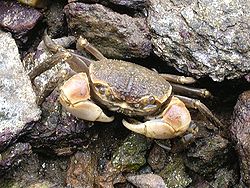| Chasmagnathus | |
|---|---|
 | |
| Scientific classification | |
| Kingdom: | Animalia |
| Phylum: | Arthropoda |
| Class: | Malacostraca |
| Order: | Decapoda |
| Suborder: | Pleocyemata |
| Infraorder: | Brachyura |
| Family: | Varunidae |
| Genus: | Chasmagnathus De Haan, 1833 [1] |
| Species: | C. convexus |
| Binomial name | |
| Chasmagnathus convexus (De Haan, 1835) [1] | |
| Synonyms [1] | |
| |
Chasmagnathus convexus is a common mud-flat crab of the family Varunidae, which is endemic to East Asia. [2] [3] In Japan, this crab is commonly called hamagani. This crab has two forms that differ in color; one is olive green and the other is purple. [2] Differences in diet are believed to be responsible for the color variation between the two forms. C. convexus is large, relative to related crabs, and can reach 4.5 to 5 centimetres (1.8 to 2.0 in) wide across its carapace. [4] It is predominantly nocturnal. [2]
